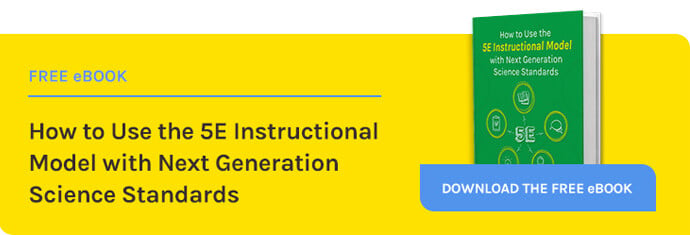
The widely established 5E teaching sequence – which includes the progressive stages Engage, Explore, Explain, Elaborate, and Evaluate – is helpful for informing the design of science programs, units, and lessons.
However, it’s important to pose the question: Does their current incarnation actually work to support the Next Generation Science Standards and deepen STEM (science, technology, engineering and math) learning in our students, or does it require adaptation to best serve NGSS?
The 5Es are an instructional model encompassing the phases Engage, Explore, Explain, Elaborate, and Evaluate, steps which educators have traditionally taught students to move through in phases.
First, instructors open a lesson with an activity or question meant to engage students, snag their interest, and offer the opportunity for them to share what they already know on the subject. This phase might include helping them make connections between their preexisting knowledge base and the new ideas that will come down the pipeline in the lesson or unit. Many educators use traditional KWL charts, in which students list what they already know and what they want to learn during this step. At the end of the lesson, students go back to this chart to list what they learned.
After engage comes explore, in which students carry out hands-on activities. Through their experiments or other interactions with the material, they deepen their understanding of the content.
Once they’ve explored, students attempt to explain what they have learned and experienced with help from the teacher – who only then explains concepts or terms encountered during exploration.
From there, students elaborate on their understanding, applying what they’ve learned to new situations to deepen their skills. In the final phase, students evaluate, reflecting on and providing evidence of their new understanding of the material.
At first glance, this seems like a good model for hands-on, student-centered instructional learning. However, this model misfires in one critical sense: it is used as a linear progression. Engagement comes first, exploring, explaining, and elaborating follow, and then evaluating wraps up the process.

The issue with this approach is that the 5Es are not actually a linear progression. Engaging is not separate from exploring. Exploring is not necessarily separate from explaining. Part of exploring requires elaborating. All of these elements require evaluating.
Each step informs the others, even when they are more than once removed. To think of these phases in a linear sense, or to structure a lesson plan in this way, does not set students up to become scientists and engineers in the way required by the Next Generation Science Standards.
That doesn’t mean we should throw the baby out with the bathwater. The 5Es are still an incredibly useful tool in teaching and learning.
The 5E Model and NGSS
If it is to be of use with the Next Generation Science Standards, the 5E instructional model must move from a traditional model of instruction to a next generation model of instruction. Specifically, here is how it looks for each of the Es:
- “Engage” transitions from “I tell them or show them” to helping students reflect on what they already know and ask questions about what they don’t yet understand, which propels them toward an initial feeling of dissatisfaction.
- “Explore” moves away from thoughts such as “I give them,” “I demonstrate,” or “They look at a model” and toward students themselves unpacking the problem, developing a model, and gathering data.
- “Explain” no longer means turning and talking, having a carousel discussion, or asking questions like “What did” and “What was.” Now, it means digging deeply into where the question has been answered or the problem solved, and using evidence to support claims.
- "Elaborate" is less about reading, watching or introducing new ideas, and more about forging the incredibly valuable concept-to-self, concept-to-concept and concept-to-world connections that help tie anchor and investigative phenomena together.
- “Evaluate” cannot simply mean vocabulary assessments or graded journals anymore; now it means reflecting critically on the investigative process, the hypothesis, and the anchor phenomena.

That's why we really see these Next Generation Science Standards as going beyond linear, two-dimensional models. This approach is not enough anymore; it is the formation of skills, and the ability to develop and use content, that is so vital to the classroom experience today.
This post was updated on Sept. 19, 2023.





